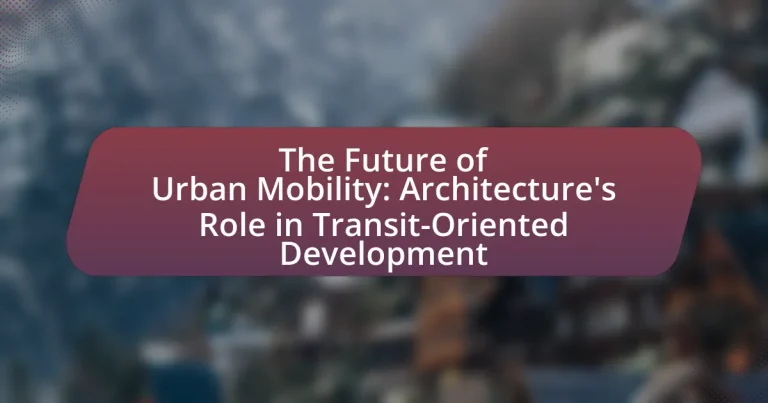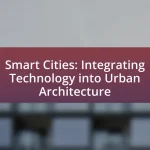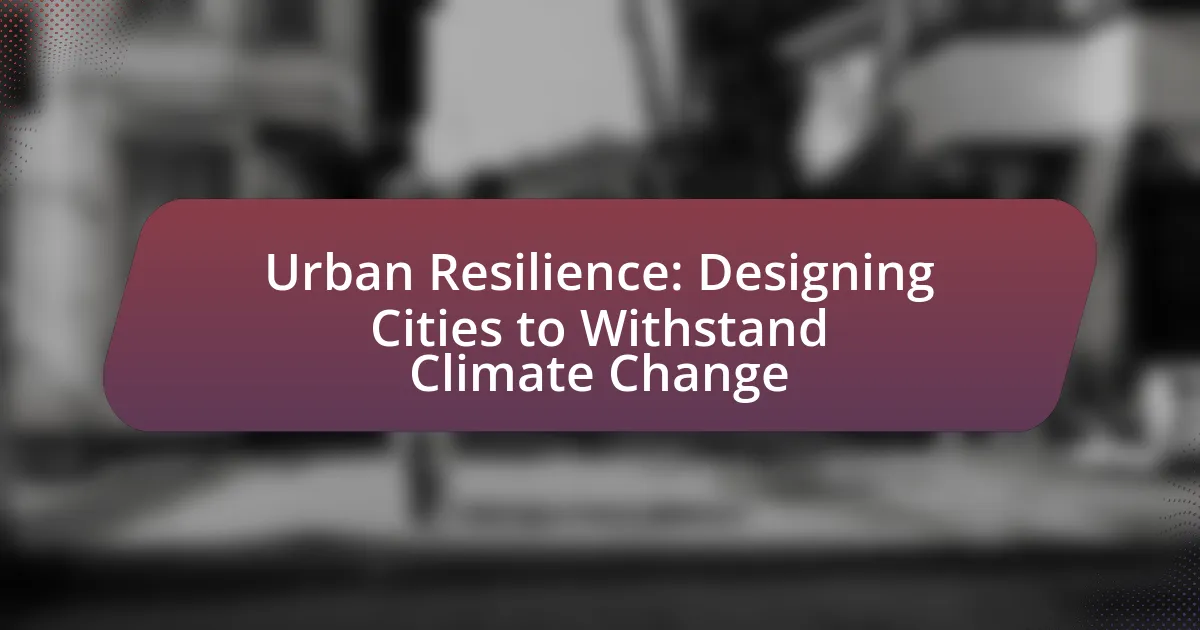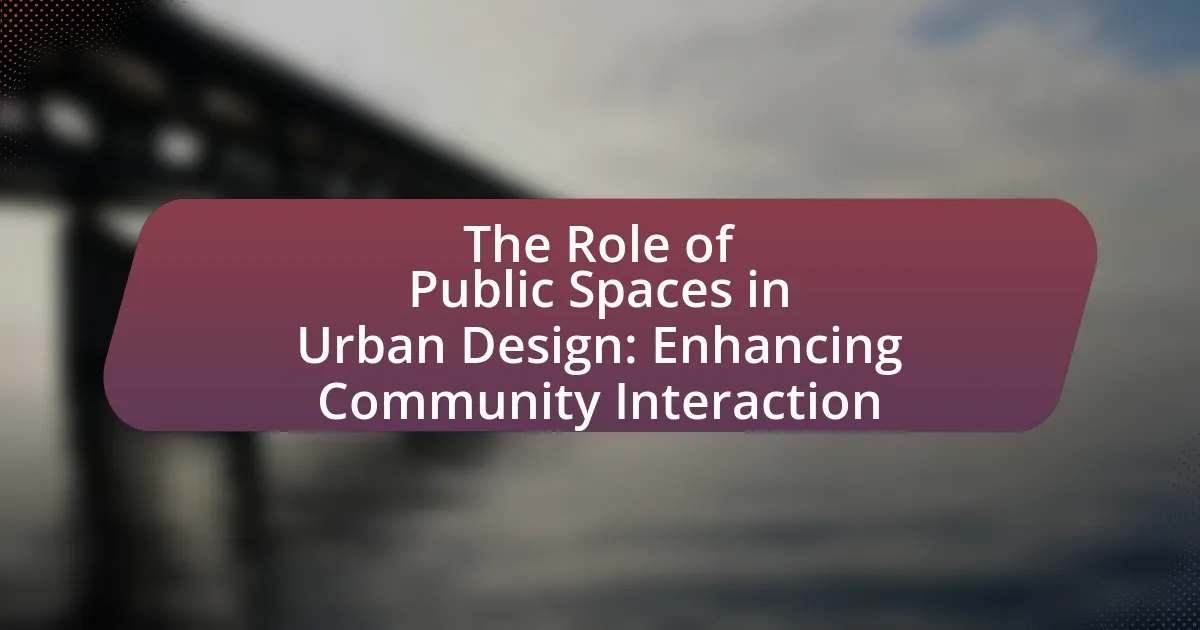The article focuses on the future of urban mobility, emphasizing the critical role of architecture in Transit-Oriented Development (TOD). It explores how technological advancements, sustainability, and multimodal transportation systems are reshaping urban environments to address challenges such as congestion and pollution. Key trends include the rise of electric vehicles, increased public transportation investment, and the integration of smart technologies. The article also discusses the principles of TOD, its benefits for economic growth and public health, and the architectural strategies necessary for successful implementation, highlighting the importance of collaboration between architects and urban planners in creating accessible and livable urban spaces.
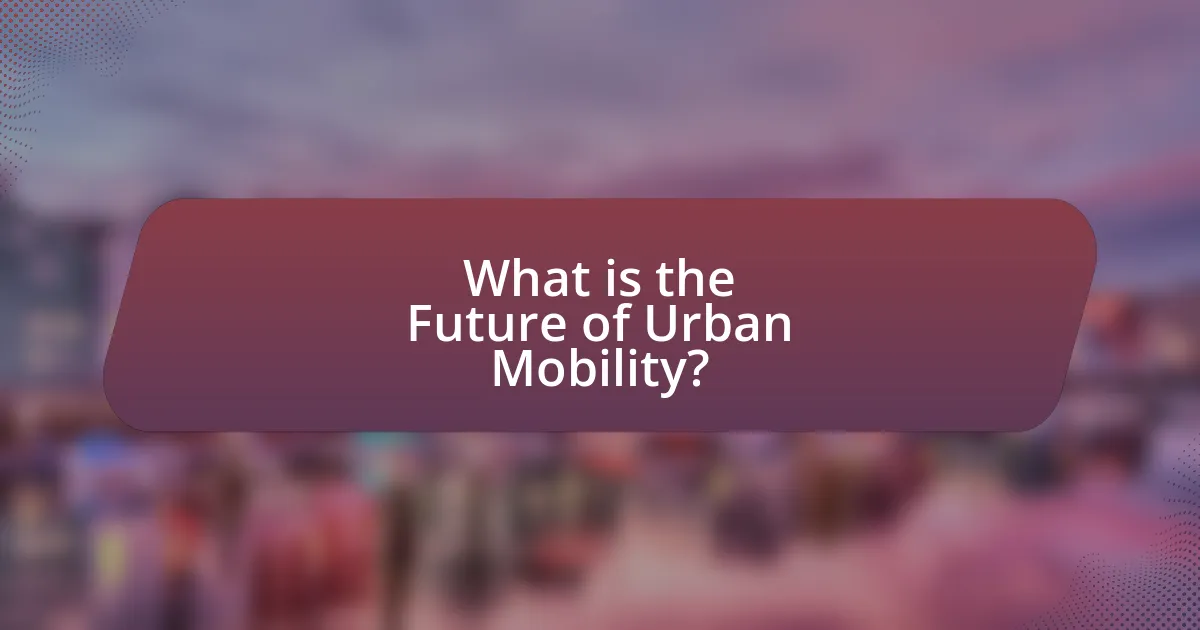
What is the Future of Urban Mobility?
The future of urban mobility is characterized by increased integration of technology, sustainability, and multimodal transportation systems. As cities face challenges such as congestion and pollution, innovations like electric vehicles, autonomous transport, and smart infrastructure are being prioritized to enhance efficiency and reduce environmental impact. For instance, a report by the International Transport Forum indicates that electric vehicles could account for 30% of urban transport by 2030, significantly lowering greenhouse gas emissions. Additionally, the rise of shared mobility services, such as ride-sharing and bike-sharing, is reshaping how urban residents navigate their environments, promoting a shift away from car ownership. This evolution in urban mobility is essential for creating more livable, accessible, and resilient cities.
How is urban mobility evolving in contemporary cities?
Urban mobility in contemporary cities is evolving through the integration of technology, sustainable practices, and multimodal transportation systems. Cities are increasingly adopting smart technologies, such as real-time data analytics and mobile applications, to enhance public transportation efficiency and user experience. For instance, the rise of electric scooters and bike-sharing programs reflects a shift towards more sustainable and flexible transportation options, reducing reliance on personal vehicles. Additionally, urban planning is increasingly focused on transit-oriented development, which prioritizes accessibility to public transport hubs, thereby promoting walkability and reducing traffic congestion. According to a report by the International Transport Forum, cities that implement these strategies can reduce greenhouse gas emissions by up to 30% by 2030, highlighting the effectiveness of these evolving urban mobility solutions.
What are the key trends shaping urban mobility today?
Key trends shaping urban mobility today include the rise of electric vehicles, increased investment in public transportation, the integration of smart technology, and a focus on sustainable practices. Electric vehicles are gaining popularity due to their environmental benefits, with sales projected to reach 30% of global car sales by 2030. Public transportation systems are being enhanced to accommodate growing urban populations, with cities like London investing billions in infrastructure improvements. Smart technology, such as real-time data analytics and mobile apps, is being integrated into transportation systems to improve efficiency and user experience. Additionally, urban planners are prioritizing sustainable practices, promoting walkability and cycling to reduce carbon footprints and enhance quality of life in urban areas.
How do technological advancements influence urban mobility?
Technological advancements significantly enhance urban mobility by improving transportation efficiency, accessibility, and sustainability. Innovations such as ride-sharing apps, electric vehicles, and smart traffic management systems streamline travel, reduce congestion, and lower emissions. For instance, a study by the International Transport Forum found that ride-sharing services can decrease the number of vehicles on the road by up to 20%, leading to less traffic and improved air quality. Additionally, the integration of real-time data analytics in public transit systems allows for better route planning and scheduling, making public transport more reliable and user-friendly. These advancements collectively contribute to a more efficient urban mobility landscape.
Why is urban mobility important for sustainable development?
Urban mobility is crucial for sustainable development because it directly influences environmental sustainability, economic growth, and social equity. Efficient urban mobility systems reduce greenhouse gas emissions by promoting public transportation and non-motorized transport options, which are essential for combating climate change. For instance, cities that invest in public transit can reduce per capita carbon emissions by up to 45% (International Energy Agency, 2021). Furthermore, improved mobility enhances access to jobs, education, and services, fostering economic opportunities and social inclusion. Studies show that well-designed transit systems can increase property values and stimulate local economies, demonstrating the interconnectedness of urban mobility and sustainable development.
What role does urban mobility play in reducing carbon footprints?
Urban mobility significantly reduces carbon footprints by promoting efficient transportation options that minimize reliance on fossil fuels. Efficient urban mobility systems, such as public transit, cycling, and walking, decrease the number of individual car trips, which are major contributors to greenhouse gas emissions. For instance, a study by the American Public Transportation Association found that public transit use saves approximately 45 million metric tons of carbon dioxide annually, equivalent to the emissions from 9.2 million cars. By enhancing accessibility and connectivity, urban mobility initiatives encourage sustainable travel behaviors, further contributing to lower carbon emissions in urban areas.
How does improved mobility enhance quality of life in urban areas?
Improved mobility enhances quality of life in urban areas by increasing accessibility to essential services, reducing travel time, and promoting social interactions. Enhanced transportation options, such as public transit and bike lanes, allow residents to reach jobs, healthcare, and education more efficiently, leading to better economic opportunities and health outcomes. According to a study by the American Public Transportation Association, communities with high public transit accessibility experience a 10% increase in employment rates. Furthermore, improved mobility fosters community engagement by connecting people to cultural and recreational activities, thereby enriching social networks and overall well-being.
-2.webp)
What is Transit-Oriented Development (TOD)?
Transit-Oriented Development (TOD) is a planning strategy that focuses on creating compact, walkable communities centered around high-quality public transportation systems. This approach aims to reduce reliance on cars, promote sustainable urban growth, and enhance accessibility to transit services. Evidence of its effectiveness can be seen in cities like Portland, Oregon, where TOD initiatives have led to increased public transit ridership and reduced traffic congestion, demonstrating the positive impact of integrating land use with transportation planning.
How does TOD integrate transportation and urban planning?
Transit-Oriented Development (TOD) integrates transportation and urban planning by creating mixed-use communities centered around high-quality public transit systems. This approach encourages higher density development near transit stations, reducing reliance on automobiles and promoting sustainable transportation options. Evidence of TOD’s effectiveness can be seen in cities like Portland, Oregon, where the implementation of light rail has led to increased property values and reduced traffic congestion, demonstrating the positive impact of aligning urban planning with transportation infrastructure.
What are the core principles of Transit-Oriented Development?
The core principles of Transit-Oriented Development (TOD) include mixed-use development, high-density housing, pedestrian-friendly design, and proximity to public transit. Mixed-use development integrates residential, commercial, and recreational spaces to create vibrant communities. High-density housing promotes efficient land use and supports public transit viability by increasing ridership. Pedestrian-friendly design prioritizes walkability, ensuring safe and accessible pathways for residents. Proximity to public transit hubs encourages the use of sustainable transportation options, reducing reliance on cars. These principles collectively aim to create sustainable, livable urban environments that enhance mobility and reduce environmental impact.
How does TOD promote mixed-use development?
Transit-Oriented Development (TOD) promotes mixed-use development by integrating residential, commercial, and recreational spaces within close proximity to public transit hubs. This approach encourages higher density living and reduces reliance on automobiles, fostering walkable communities where people can live, work, and play in the same area. Studies show that TOD areas typically see a 20-30% increase in mixed-use developments compared to traditional zoning, as they attract diverse populations and businesses due to their accessibility and convenience.
What are the benefits of Transit-Oriented Development?
Transit-Oriented Development (TOD) offers multiple benefits, including reduced traffic congestion, increased public transit usage, and enhanced community livability. By concentrating housing, jobs, and services near transit hubs, TOD encourages people to rely on public transportation rather than personal vehicles, leading to a decrease in greenhouse gas emissions. Studies show that areas developed with TOD principles can experience a 20-40% increase in public transit ridership, as evidenced by the success of projects in cities like Portland and San Francisco. Additionally, TOD promotes walkability and cycling, fostering healthier lifestyles and vibrant neighborhoods.
How does TOD contribute to economic growth in urban areas?
Transit-Oriented Development (TOD) contributes to economic growth in urban areas by increasing accessibility and promoting higher density development around transit hubs. This approach leads to enhanced property values, as studies show that properties near transit stations can appreciate by 10-30% more than those further away. Additionally, TOD encourages mixed-use developments, which create jobs and stimulate local businesses, resulting in a more vibrant economy. For instance, a report by the American Public Transportation Association indicates that every $1 invested in public transit generates approximately $4 in economic returns, highlighting the significant impact of TOD on urban economic vitality.
What impact does TOD have on public health and community well-being?
Transit-Oriented Development (TOD) positively impacts public health and community well-being by promoting active transportation, reducing vehicle dependency, and enhancing access to essential services. Research indicates that TOD encourages walking and cycling, which can lead to increased physical activity levels among residents, thereby reducing obesity rates and related health issues. A study published in the Journal of Urban Health found that neighborhoods with higher walkability, often associated with TOD, have lower rates of chronic diseases such as diabetes and heart disease. Additionally, TOD fosters social interaction and community cohesion by creating vibrant public spaces, which can improve mental health and overall quality of life.
What is Architecture’s Role in Transit-Oriented Development?
Architecture plays a crucial role in Transit-Oriented Development (TOD) by designing spaces that enhance accessibility and promote sustainable urban living. Effective architectural design in TOD integrates residential, commercial, and public spaces within walking distance of transit hubs, thereby reducing reliance on automobiles. For instance, the design of mixed-use developments encourages higher density and fosters community interaction, which is essential for vibrant urban environments. Studies show that well-planned TOD can increase public transit ridership by up to 30%, demonstrating the impact of architecture on urban mobility and sustainability.
How can architecture enhance the effectiveness of TOD?
Architecture can enhance the effectiveness of Transit-Oriented Development (TOD) by creating integrated spaces that promote accessibility and connectivity. Thoughtfully designed buildings and public spaces can facilitate seamless transitions between different modes of transportation, such as buses, trains, and bicycles, thereby reducing reliance on cars. For instance, the design of mixed-use developments encourages walking and cycling by placing residential, commercial, and recreational facilities within close proximity to transit stations. Research from the American Planning Association indicates that well-planned TOD can increase public transit ridership by up to 30%, demonstrating the direct impact of architectural design on transit efficiency and urban mobility.
What design strategies are essential for successful TOD projects?
Essential design strategies for successful Transit-Oriented Development (TOD) projects include mixed-use development, pedestrian-friendly infrastructure, and integrated transit systems. Mixed-use development promotes a blend of residential, commercial, and recreational spaces, which enhances accessibility and reduces reliance on cars. Pedestrian-friendly infrastructure, such as wide sidewalks, safe crossings, and bike lanes, encourages walking and cycling, fostering a vibrant community atmosphere. Integrated transit systems ensure seamless connections between various modes of transportation, improving overall mobility and reducing congestion. These strategies are supported by studies indicating that TOD projects with these elements lead to increased public transit usage and higher property values, demonstrating their effectiveness in creating sustainable urban environments.
How does architectural design influence user experience in transit hubs?
Architectural design significantly influences user experience in transit hubs by shaping the flow, accessibility, and comfort of the space. Effective design facilitates intuitive navigation, reducing confusion and wait times, which enhances overall satisfaction. For instance, research by the American Institute of Architects indicates that well-designed transit spaces can improve user perception of safety and efficiency, leading to increased ridership. Additionally, elements such as natural lighting, clear signage, and comfortable seating contribute to a more pleasant environment, directly impacting user experience.
What challenges does architecture face in implementing TOD?
Architecture faces several challenges in implementing Transit-Oriented Development (TOD), primarily related to land use, community resistance, and integration with existing infrastructure. Land use challenges arise from the need to balance high-density development with the preservation of open spaces and community character. Community resistance often stems from concerns about increased traffic, changes in neighborhood dynamics, and potential displacement of current residents. Additionally, integrating TOD with existing infrastructure can be complex, as it requires coordination between various stakeholders, including government agencies, transportation authorities, and private developers. These challenges are supported by studies indicating that successful TOD implementation often hinges on addressing these multifaceted issues effectively.
How can architects address the complexities of urban environments?
Architects can address the complexities of urban environments by integrating sustainable design principles, enhancing connectivity, and prioritizing mixed-use developments. Sustainable design principles, such as green roofs and energy-efficient materials, reduce environmental impact and improve urban resilience. Enhancing connectivity through well-planned transit systems and pedestrian pathways facilitates movement and accessibility, which is crucial in densely populated areas. Prioritizing mixed-use developments encourages vibrant communities by combining residential, commercial, and recreational spaces, fostering social interaction and economic activity. These strategies are supported by studies indicating that well-designed urban environments can lead to increased quality of life and reduced traffic congestion, as seen in cities like Copenhagen and Portland, which have successfully implemented transit-oriented development.
What are the common pitfalls in TOD architectural design?
Common pitfalls in Transit-Oriented Development (TOD) architectural design include inadequate integration of transportation systems, neglecting community needs, and poor land use planning. Inadequate integration can lead to disjointed transit options, making it difficult for residents to access public transport effectively. Neglecting community needs often results in developments that do not reflect the desires or requirements of local populations, leading to social discontent. Poor land use planning can create congestion and inefficiencies, undermining the very purpose of TOD, which aims to promote sustainable urban growth. These pitfalls have been documented in various studies, highlighting the importance of a holistic approach to ensure successful TOD outcomes.
What are best practices for architects in Transit-Oriented Development?
Best practices for architects in Transit-Oriented Development (TOD) include designing mixed-use spaces that integrate residential, commercial, and recreational areas within close proximity to transit stations. This approach enhances accessibility and encourages public transport use, reducing reliance on cars. Architects should prioritize pedestrian-friendly environments by incorporating wide sidewalks, safe crossings, and amenities that promote walking and cycling. Additionally, utilizing sustainable building materials and energy-efficient designs contributes to environmental goals and community well-being. Evidence from successful TOD projects, such as the Arlington, Virginia, model, demonstrates that these strategies lead to increased transit ridership and improved quality of life for residents.
How can architects collaborate with urban planners for effective TOD?
Architects can collaborate with urban planners for effective Transit-Oriented Development (TOD) by integrating design principles that prioritize accessibility, sustainability, and community engagement. This collaboration involves architects contributing their expertise in creating functional and aesthetically pleasing spaces that enhance public transit systems, while urban planners provide the regulatory framework and strategic vision for land use around transit hubs. For instance, studies show that mixed-use developments near transit stations can increase ridership by up to 30%, demonstrating the impact of thoughtful architectural design on urban mobility. By working together, architects and urban planners can ensure that TOD projects meet both the practical needs of transportation and the social needs of the community.
What innovative solutions can architects propose for future urban mobility challenges?
Architects can propose innovative solutions for future urban mobility challenges by designing mixed-use developments that integrate transportation hubs with residential and commercial spaces. This approach encourages walkability and reduces reliance on cars, as seen in cities like Copenhagen, where urban planning prioritizes cycling and public transport access. Additionally, architects can implement smart infrastructure, such as adaptive traffic signals and real-time transit information systems, which enhance the efficiency of urban mobility. Research from the Urban Land Institute indicates that transit-oriented developments can increase public transit ridership by up to 30%, demonstrating the effectiveness of these architectural strategies in addressing urban mobility issues.
